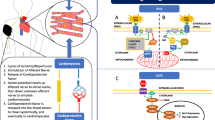High molecular weight peptide(s) operate as the trigger for remote postconditioning (RPC) of the heart. Nitric oxide and adenosine function as mediators between peptide and intracellular structures. The autonomic nervous system does not have a role in RPC. The signal mechanism of RPC involves protein kinase C, PI3 kinase, Akt kinase, and aldehyde dehydrogenase. The hypothetical end effector of RPC is the BKCa channel
Similar content being viewed by others
References
N. K. Zenkov, V. Z. Lankin, and E. B. Men’shchikova, Oxidative Stress: Biochemical and Pathophysiological Aspects, MAIK Nauka/Interperiodika, Moscow (2001).
V. A. Markov, V. V. Ryabov, I. V. Maksimov, et al., “Yesterday, today, tomorrow in the diagnosis and treatment of acute myocardial infarction,” Sib. Med. Zh. (Tomsk), 26, No. 2, B. 1, 8–14 (2011).
E. V. Shlyakhto, E. M. Nifontov, and M. M. Galagudza, “Pre- and postconditioning as means of cardioprotection. Pathophysiological and clinical aspects,” Zh. Serdech. Nedostat., 9, No. 1, 4–10 (2008).
M. Basalay, V. Barsukevich, S. Mastitskaya, et al., “Remote ischaemic pre- and delayed postconditioning – similar degree of cardioprotection but distinct mechanisms,” Exp. Physiol., 97, No. 8, 908–917 (2012).
L. Breivik, E. Helgeland, E. K. Aarnes, et al., “Remote postconditioning by humoral factors in effluent from ischemic preconditioned rat hearts is mediated via PI3K/Akt-dependent cell-survival signaling at reperfusion,” Basic Res. Cardiol., 106, No. 1, 135–145 (2011).
S. Candia, M. L. Garcia, and R. Latorre, “Mode of action of iberiotoxin, a potent blocker of the large conductance Ca2+-activated K+ channel,” Biophys. J., 63, No. 2, 583–590 (1992).
C. H. Chen, G. R. Budas, E. N. Churchill, et al., “Activation of aldehyde dehydrogenase-2 reduces ischemic damage to the heart,” Science, 321, No. 5895, 1493–1495 (2008).
M. V. Cohen and J. M. Downey, “Is it time to translate ischemic preconditioning’s mechanism of cardioprotection into clinical practice?” J. Cardiovasc. Pharmacol. Ther., 16, No. 3–4, 273–280 (2011).
Q. Gao, J. Hu, J. Hu, et al., “Calcium activated potassium channel and protein kinase C participate in the cardiac protection of remote post conditioning,” Pak. J. Pharm. Sci., 26, No. 2, 285–290 (2013).
W. K. Jones, G. C. Fan, S. Liao, et al., “Peripheral nociception associated with surgical incision elicits remote nonischemic cardioprotection via neurogenic activation of protein kinase C signaling,” Circulation, 120, No. 1, Supplement, S1–S9 (2009).
F. Kerendi, H. Kin, M. E. Halkos, et al., “Remote postconditioning. Brief renal ischemia and reperfusion applied before coronary artery reperfusion reduces myocardial infarct size via endogenous activation of adenosine receptors,” Basic Res. Cardiol., 100, No. 5, 404–412 (2005).
R. E. Klabunde, “Dipyridamole inhibition of adenosine metabolism in human blood,” Eur. J. Pharmacol., 93, No. 1–2, 21–26 (1983).
Y. J. Li, Z. S. Zhao, C. F. Peng, and H. W. Deng, “Calcitonin gene-related peptide-induced preconditioning protects against ischemia-reperfusion injury in isolated rat hearts,” Eur. J. Pharmacol., 311, No. 2–3, 163–167 (1996).
P. Pennefather, B. Lancaster, P. R. Adams, and R. A. Nicoll, “Two distinct Ca-dependent K currents in bullfrog sympathetic ganglion cells,” Proc. Natl. Acad. Sci. USA, 82, No. 9, 3040–3044 (1985).
O. H. Petersen and Y. Maruyama, “Calcium-activated potassium channels and their role in secretion,” Nature, 307, No. 5953, 693–696 (1984).
F. C. Serejo, L. F. Rodrigues, K. C. da Silva Tavares, et al., “Cardioprotective properties of humoral factors released from rat hearts subject to ischemic preconditioning,” J. Cardiovasc. Pharmacol., 49, No. 4, 214–220 (2007).
Y. H. Tang, J. J. Xu, J. X. Li, and X. S. Cheng, “Remote postconditioning induced by brief pulmonary ischemia and reperfusion attenuates myocardial reperfusion injury in rabbits,” Chin. Med. J. (Engl.), 124, No. 11, 1683–1688 (2011).
Y. H. Tang, J. S. Yang, H. Y. Xiang, and J. J. Xu, “PI3K-Akt/eNOS in remote postconditioning induced by brief pulmonary ischemia,” Clin. Invest. Med., 37, No. 1, E26–E37 (2014).
A. Trautmann and A. Marty, “Activation of Ca-dependent K channels by carbamoylcholine in rat lacrimal glands,” Proc. Natl. Acad. Sci. USA, 81, No. 2, 611–615 (1984).
Q. Wang, Y. Cheng, F. S. Xue, et al., “Postconditioning with vagal stimulation attenuates local and systemic inflammatory responses to myocardial ischemia reperfusion injury in rats,” Inflamm. Res., 61, No. 11, 1273–1282 (2012).
D. M. Yellon and J. M. Downey, “Preconditioning the myocardium: from cellular physiology to clinical cardiology,” Physiol. Rev., 83, No. 4, 1113–1151 (2003).
Y. Yu, X. J. Jia, Q. F. Zong, et al., “Remote ischemic postconditioning protects the heart by upregulating ALDH2 expression levels through the PI3K/Akt signaling pathway,” Mol. Med. Rep., 10, No. 1, 536–542 (2014).
Author information
Authors and Affiliations
Corresponding author
Additional information
Translated from Rossiiskii Fiziologicheskii Zhurnal imeni I. M. Sechenova, Vol. 101, No. 10, pp. 1097–1102, October, 2015.
Rights and permissions
About this article
Cite this article
Maslov, L.N., Mukhomedzyanov, A.V. & Sementsov, A.S. Trigger and Signal Mechanisms and the End Effector of the Cardioprotective Effect of Remote Postconditioning of the Heart. Neurosci Behav Physi 47, 186–189 (2017). https://doi.org/10.1007/s11055-016-0384-9
Received:
Published:
Issue Date:
DOI: https://doi.org/10.1007/s11055-016-0384-9



